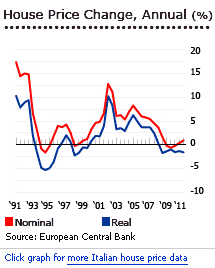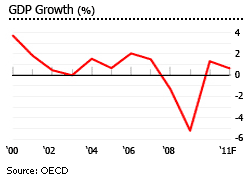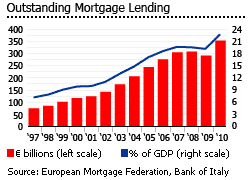Bye bye bunga bunga

A new Italian government headed by Mario Monti, a respected economist and former European Commissioner, has replaced the government of Silvio Berlusconi, who had dominated Italian politics for 17 years.
Will it help Italy’s housing market? With 0.5% annual house prices increases during the year to H1 2011 reported by the Bank of Italy, in real terms house prices fell 1.2%.
More pessimistically, the respected think-tank Nomisma declared house prices had fallen 0.7% (nominal) in 13 major cities, with existing home prices down 0.6%. There was also a 6.6% drop in housing sales (seasonally adjusted) during the year to Q2 2011.
Nomisma expects things to get worse.
Real estate agents are however more optimistic, expecting more sales mandates over the next few months, according to a Bank of Italy survey in October 2011.
Italy’s GDP growth was 0.8% during the year to Q2 2011, supported by net exports and a slight improvement in domestic demand. Not so bad – but GDP growth of only 0.6% is expected for the full year 2011, with even lower growth in 2012.
A new government at last!

Berlusconi’s coalition was weakened corruption allegations and sex scandals, and under the pressure of enormous borrowing costs and the euro crisis, he resigned on November 12, after losing a crucial vote in parliament.
Is Italy being unfairly treated?
Before Berlusconi resigned, Italy’s deficit was only 4.6% of GDP in 2010, down from last year’s 5.4% deficit. Italy’s senate approved the 2012 austerity plan which cuts the deficit to 1.4% of GDP in 2012 ´and will actually balance the budget in 2013, according to Economy Minister Giulio Tremonti.
Yet Italy’s credit ratings were recently downgraded by rating agencies:
- Fitch Rating cut its credit rating from A+ to AA-
- Moody’s downgraded its rating from Aa2 to A2
- Standard & Poor’s Ratings Services cut its long- and short-term sovereign credit rating from A+/A-1 to A/A-1
The cafes are full, the country is buzzing. What gives?
True, Italy GDP growth of 1.3% in 2010 was lower than other major European economies such as Germany (3.5%), UK (1.8%) and France (1.6%). But in a country like Italy, who can be sure GDP growth figures reflect reality?
Perhaps this crisis has been somewhat overdone?Landlordism is unattractive in Italy
Renting is unattractive for Italian landlords, because of rent controls and other restrictions. Rental properties have long yielded poor returns. Properties generally have low yields of 3% to 5%, according to Global Property Guide.
In June 2010:
- apartments in the historical centre of Rome had rental yields of 3.45% - 4.40%
- apartments in Rome’s suburbs had yields ranging from 3% to 4.5%
- `apartments in Milan had yields ranging from 3.39% to 3.76%

When a law was passed in 1978 encouraging landlords to sell, a lot of landlords grabbed the chance.
The standard contract allows free negotiation of the initial rent, but commits the landlord to a four-year contract and gives the tenant the option of extending for another four years. Rents can only be increased annually by 75% of the cost of living index; i.e. if inflation is 2%, then you can only increase your rent by 1.5%.
Because of the restrictions on rent increases, most landlords prefer to ‘frontload’ long rental contracts to take account anticipated future rent increases, and inflation and capital value appreciation. Frontloading, in turn, artificially raises rents for new contracts. Despite this, average rents have failed to keep up with inflation since the mid-1990s.
While house prices rose by an average of 6.3% from 2000 to 2008, rents rose by an average of only 2.5% over the same period. In 2009 and 2010, rents rose by only 2.36%, while residential property prices dropped by an average of 0.2%.
Interest rates are low in Italy
The average interest rate for new housing loans was 2.92% from May 2009 to March 2011, but then rose to 3.42% in September 2011.
Housing loan rates in Italy, September 2011:

- Fixed rate up to 1 yr: 3.14%
- Fixed rate 1-5 yr: 3.58%
- Fixed rate 5-10 yr: 4.08%
- Fixed rate 10 yr +: 4.64%.
Italy’s interest rates reflect European Central Bank rates. Rising inflation pushed the ECB’s key rate to 1.25% in April, and 1.50% in July 2011. In November 2011, ECB’s base rate eased back to 1.25%.
Italians have little housing debt
Yet the effect of interest rate reductions is likely to be relatively small in Italy, even though most Italian housing loans are variable rate (only 36% of outstanding housing loans were fixed rate at end-2008).

That’s because Italy’s mortgage markets are smaller than those in other European countries. Outstanding mortgages were 22% of GDP in 2010, up from 7% in 1997, significantly lower than the EU’s average of 50% of GDP
Cumbersome legal processes make Italian banks cautious. From the time a borrower defaults, legal proceedings usually take from five to seven years. Italian house buyers are also reluctant to use mortgage facilities, despite tax benefits, according to the Royal Institution of Chartered Surveyors (RICS). Most households rely on personal savings for home purchases.
Italy’s homeownership rate is high
Italy is a nation of home-owners. 80% of all homes are owner-occupied, especially in the south and small towns, up from 59% in 1980.
Why the rapid increase in home ownership?
- Mortgage borrowing is now much easier.
- Living standards have risen, despite relatively slow economic growth.
- There are tax breaks for ownership, mortgage relief, and low value assessments when calculating imputed income tax and capital gains taxes
- New housing supply is almost exclusively destined for homeownership
- The Fair Rent Act of 1978 established a common four-year lease, enabling landlords to sell, and continued rent controls